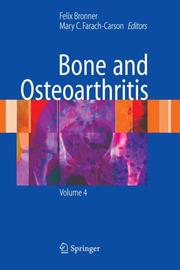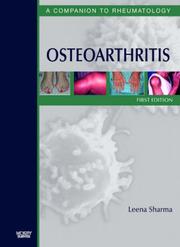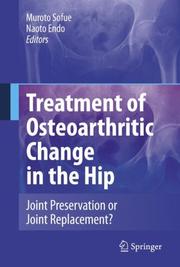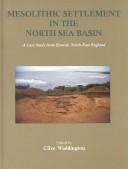| Listing 1 - 8 of 8 |
Sort by
|
Dissertation
ISBN: 9789036731119 Year: 2007 Publisher: Wageningen Ponsen en Looijen
Abstract | Keywords | Export | Availability | Bookmark
 Loading...
Loading...Choose an application
- Reference Manager
- EndNote
- RefWorks (Direct export to RefWorks)
Bacterial Adhesion --- Contact Lenses, Extended-Wear --- Cornea --- Staphylococcus aureus --- Pseudomonas aeruginosa --- Contact Lenses --- physiology --- microbiology --- microbiology --- physiology --- physiology --- microbiology

ISBN: 1846287014 1846285135 Year: 2007 Volume: v. 4 Publisher: London : Springer,
Abstract | Keywords | Export | Availability | Bookmark
 Loading...
Loading...Choose an application
- Reference Manager
- EndNote
- RefWorks (Direct export to RefWorks)
Bone and Osteoarthritis places emphasis on the molecular and cellular events that lead to osteoarthritis, stressing the role of subchondral bone, which distinguishes this from other books on the disease. A novel aspect is the attention given to the possible epigenetic basis, together with a discussion of the genetics predisposing to osteoarthritis. Detailed analyses are given of the role of the synovium, of the molecular mechanisms that lead to degradation of the cartilage matrix, of the hypertrophy of the cartilage cell, of the anabolic and catabolic roles of cytokines, may lead to novel approaches to clinical treatment, utilizing anabolic mediators or molecules that target steps in the disease process. Also discussed are animal models and how mechano-responsiveness is compromised by mechanical injury. Orthopedics and rheumatology have become close conceptually, as advances in bone and joint biology have enabled bench and translational scientists, as well as practitioners, to approach clinical problems comprehensively. Because bone plays a role in initiating osteoarthritis, therapeutic approaches focusing on bone tissue are included in the discussion of novel treatments. The general topic of osteoarthritis is therefore a timely subject for a series on bone biology. This book, intended for clinicians, researchers and students, provides information that will orient the novice and update the specialist. No other book treats the relationship of bone to osteoarthritis in similar fashion or provides a comparable underpinning of joint pathophysiology.
Osteoarthritis --- Bone. --- Pathogenesis. --- Bones --- Calcification --- Connective tissues --- Skeleton --- Degenerative arthritis --- Degenerative joint disease --- Joint disease, Degenerative --- OA (Disease) --- Old age arthritis --- Osteoarthrosis --- Wear and tear arthritis --- Arthritis
Periodical
Abstract | Keywords | Export | Availability | Bookmark
 Loading...
Loading...Choose an application
- Reference Manager
- EndNote
- RefWorks (Direct export to RefWorks)
Tribology --- Friction --- Surfaces (Technology) --- Tribologie (Technologie) --- Frottement --- Surfaces (Technologie) --- Periodicals. --- Periodicals --- Périodiques --- Tribology. --- friction --- lubrication --- wear --- Engineering sciences. Technology --- tribologie --- Mechanical Engineering - General

ISBN: 0323070647 0323039294 1336227257 9780323070645 9780323039291 Year: 2007 Publisher: Philadelphia Mosby
Abstract | Keywords | Export | Availability | Bookmark
 Loading...
Loading...Choose an application
- Reference Manager
- EndNote
- RefWorks (Direct export to RefWorks)
This new companion to Hochberg et al.'s Rheumatology masterwork presents current insights into the causes, detection, and therapy of this condition. It provides ""one-stop"" coverage of scientific and clinical developments, including new concepts in epidemiology and genetics and pathogenic mechanisms · new developments in diagnostic interventions and prevention · and the very latest concepts in treatment.Features the work of leading experts in osteoarthritis. Presents current diagnostic criteria and knowledge of pathogenic mechanisms.Discusses the very latest advances
Osteoarthritis. --- Rheumatology. --- Internal medicine --- Connective tissues --- Joints --- Degenerative arthritis --- Degenerative joint disease --- Joint disease, Degenerative --- OA (Disease) --- Old age arthritis --- Osteoarthrosis --- Wear and tear arthritis --- Arthritis --- Diseases
Book
ISBN: 6611733566 1281733563 9786611733568 1607502658 6000005121 1435625161 9781607502654 9781435625167 9781433711411 1433711419 1586037730 9781586037734 Year: 2007 Publisher: Amsterdam Washington, DC IOS Press
Abstract | Keywords | Export | Availability | Bookmark
 Loading...
Loading...Choose an application
- Reference Manager
- EndNote
- RefWorks (Direct export to RefWorks)
Osteoarthritis is a major public health issue due to its impact in term of handicap. Moreover, ageing of the world population and outbreak of obesity in industrialized and non-industrialized countries will dramatically increase its incidence in the next years. Regarded as a multi-factorial disease, today mechanistic and inflammatory theories are no more opposed but, on the contrary, are framed within the same continuum: osteoarthritis, inflammation and degeneration.In order to collect major information in a benchmark book on the fundamental aspects of this disease, internationally well-known a
Biochemical markers. --- Osteoarthritis. --- Degenerative arthritis --- Degenerative joint disease --- Joint disease, Degenerative --- OA (Disease) --- Old age arthritis --- Osteoarthrosis --- Wear and tear arthritis --- Arthritis --- Biologic markers --- Biological markers --- Biomarkers --- Markers, Biochemical --- Biochemistry --- Indicators (Biology)

ISBN: 1280865660 9786610865666 4431382003 4431381988 Year: 2007 Publisher: Tokyo ; New York : Springer,
Abstract | Keywords | Export | Availability | Bookmark
 Loading...
Loading...Choose an application
- Reference Manager
- EndNote
- RefWorks (Direct export to RefWorks)
The 32nd Japanese Hip Society (JHS) Congress was held November 6–8, 2005, in Niigata, Japan. Guest speakers from many countries and specialists for hip disease presented papers that focused on joint preservation for osteoarthritis of the hip, joint preservation for aseptic necrosis of the femoral head, treatment for epiphyseolysis capitis femoris, and up-to-date information and knowledge on joint arthroplasty. Altogether, there were many important presentations about joint preservation and replacement. This book covers the main themes of the congress. The starting point for the treatment of hip disease depends on how we can preserve the natural hip joint and on steps leading to regeneration of the diseased, injured, or destroyed joint. Preservation and regeneration treatments following traditional and theoretical methods do not need to use expensive materials, such as the arti?cial joints used in arthroplasty. On the other hand, preservation and regeneration tre- ments are dif?cult to perform and require a lengthy rehabilitation period.
Hip joint --- Osteoarthritis --- Total hip replacement --- Diseases --- Treatment --- Coxa --- Joints --- Hip arthroplasty --- Hip replacement --- Total hip arthroplasty --- Total hip joint replacement --- Arthroplasty --- Artificial hip joints --- Degenerative arthritis --- Degenerative joint disease --- Joint disease, Degenerative --- OA (Disease) --- Old age arthritis --- Osteoarthrosis --- Wear and tear arthritis --- Arthritis --- Surgery --- Orthopedic surgery. --- Surgical Orthopedics. --- Operative orthopedics --- Orthopedics --- Surgery, Operative --- Orthopedics. --- Orthopaedics --- Orthopedia

ISBN: 1782974628 1782974601 1842172468 Year: 2007 Publisher: Havertown : Oxbow Books,
Abstract | Keywords | Export | Availability | Bookmark
 Loading...
Loading...Choose an application
- Reference Manager
- EndNote
- RefWorks (Direct export to RefWorks)
The archaeological remains at Howick consist of a Mesolithic hut site and an Early Bronze Age cist cemetery located on a modern cliff edge overlooking a small estuary. This volume is devoted solely to the reporting and interpretation of the Mesolithic remains. Three huts had been constructed on the Howick site, all on the same footprint, with no evidence to indicate a gap between these occupations, and the remains inside the hut were all consistent with its use as a habitation site. The lithic material from Howick is the most accurately dated assemblage from any British Mesolithic site and is
Excavations (Archaeology) -- England -- Northumberland. --- Howick Site (England). --- Land settlement patterns, Prehistoric -- England -- Northumberland. --- Mesolithic period -- England -- Northumberland. --- Northumberland (England) -- Antiquities. --- Mesolithic period --- Land settlement patterns, Prehistoric --- Excavations (Archaeology) --- Anthropology --- Social Sciences --- Prehistoric Anthropology --- Archaeological digs --- Archaeological excavations --- Digs (Archaeology) --- Excavation sites (Archaeology) --- Ruins --- Sites, Excavation (Archaeology) --- Archaeology --- Prehistoric land settlement patterns --- Middle Stone age --- Stone age --- Northumberland (England) --- Antiquities. --- Northumberland --- County of Northumberland (England) --- Tyne and Wear (England) --- England --- Antiquities
Book
ISBN: 9781402058455 9781402058448 1402058446 1402058454 9048174554 9786611338985 1281338982 Year: 2007 Publisher: Dordrecht Springer
Abstract | Keywords | Export | Availability | Bookmark
 Loading...
Loading...Choose an application
- Reference Manager
- EndNote
- RefWorks (Direct export to RefWorks)
S. E. BAILEY Department of Human Evolution Max Planck Institute for Evolutionary Anthropology Deutscher Platz 6 D-04103 Leipzig, Germany and Center for the Study of Human Origins, Department of Anthropology, New York University, 25 Waverly Place New York, NY 10003, USA sbailey@nyu. edu J. -J. HUBLIN Department of Human Evolution Max Planck Institute for Evolutionary Anthropology Deutscher Platz 6 D-04103 Leipzig, Germany hublin@eva. mpg. de When faced with choosing a topic to as teeth represent, by far, the most abundant be the focus of the first symposium material documenting different species of in Human Evolution at the Max Planck extinct non-human primates and hominins. As Institute for Evolutionary Anthropology in such, much of what we know about non- Leipzig, a paleoanthropological perspective human primate and hominin evolution is based of dental anthropology was a natural choice. on teeth. Teeth make up a disproportionate number Teeth have been a focus of interest for of the fossils discovered. They represent physical anthropologists over many gen- strongly mineralized organs of compact shape, ations. Teeth provide a multitude of which allow better preservation in geological information about humans – including deposits and archaeological sites than any cultural treatment, pathology, morphological other part of the skeleton. As a result, variation, and development. The presence of since the discoveries of the first fossils of culturally induced wear (toothpick grooves, extinct species, vertebrate paleontology has for example) reveals something about what been built primarily on analyses of teeth.
beeldverwerking --- Computer. Automation --- Ethnology. Cultural anthropology --- stomatologie --- Human anatomy --- vormgeving --- Artificial intelligence. Robotics. Simulation. Graphics --- simulaties --- Stomatology --- anatomie --- Teeth --- Human evolution. --- Teeth, Fossil. --- Paleoanthropology. --- Evolution (Biology). --- Dental anthropology. --- Animals. --- Humans. --- Fossils. --- Paleodontology. --- Paleodontology --- Tooth --- Tooth Wear. --- Anatomy, Comparative. --- Evolution. --- Primates. --- Hominidae. --- Biological Evolution. --- SOCIAL SCIENCE --- Methods. --- Anatomy & histology. --- Anthropology --- Physical. --- Anthropology. --- Life sciences. --- Paleontology . --- Human anatomy. --- Life Sciences, general. --- Evolutionary Biology. --- Paleontology. --- Anatomy. --- Evolutionary biology. --- Anatomy, Human --- Anatomy --- Human biology --- Medical sciences --- Human body --- Fossilogy --- Fossilology --- Palaeontology --- Paleontology, Zoological --- Paleozoology --- Historical geology --- Zoology --- Fossils --- Prehistoric animals in motion pictures --- Biosciences --- Sciences, Life --- Science --- Human beings --- Animal evolution --- Animals --- Biological evolution --- Darwinism --- Evolutionary biology --- Evolutionary science --- Origin of species --- Biology --- Evolution --- Biological fitness --- Homoplasy --- Natural selection --- Phylogeny --- Primitive societies --- Social sciences --- Dental anthropology --- Evolution (Biology) --- Human evolution --- Paleoanthropology --- Teeth, Fossil
| Listing 1 - 8 of 8 |
Sort by
|

 Search
Search Feedback
Feedback About UniCat
About UniCat  Help
Help News
News